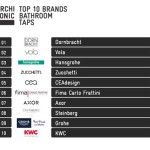Bathroom Design Ideas for 2022: Trends and Innovations
Bathroom design continues to evolve, reflecting advancements in technology, sustainability concerns, and changing aesthetic preferences. The year 2022 has brought forth a diverse range of styles, materials, and layouts, focusing on creating spaces that are not only functional but also promote relaxation and well-being. This article explores some of the key trends that shaped bathroom design in 2022, providing insights into the elements that contribute to a modern and sophisticated bathing area.
Embracing Natural Elements and Biophilic Design
One of the dominant trends in 2022 bathroom design is the integration of natural elements and biophilic design principles. This approach aims to connect the interior space with the natural world, fostering a sense of tranquility and reducing stress. This is achieved through a variety of means, including the use of natural materials, incorporation of plants, and maximizing natural light.
Natural materials like wood, stone, and bamboo are increasingly prevalent. Wood, particularly reclaimed or sustainably sourced varieties, can be used for vanities, shelving, and even wall paneling, bringing warmth and texture to the space. Stone, such as marble, granite, or slate, is often chosen for countertops, flooring, and shower walls, offering durability and a luxurious aesthetic. Bamboo, a rapidly renewable resource, is a popular choice for accessories, storage containers, and even decorative screens.
Bringing greenery into the bathroom is another essential aspect of biophilic design. Potted plants, hanging planters, and even living walls can transform the bathroom into a verdant oasis. Species that thrive in humid environments, such as ferns, orchids, and air plants, are particularly well-suited for bathroom settings. The presence of plants not only enhances the visual appeal of the space but also contributes to improved air quality.
Maximizing natural light is also crucial. Large windows, skylights, and light tubes can flood the bathroom with sunlight, creating a bright and airy atmosphere. When natural light is limited, strategically placed mirrors can help to reflect and amplify the available light. The careful selection of lighting fixtures that mimic natural light can further enhance the overall ambiance.
The Rise of Smart Bathroom Technology
Technology continues to play an increasingly significant role in bathroom design, with smart features becoming more integrated into various fixtures and appliances. Smart toilets, showers, mirrors, and lighting systems offer enhanced convenience, comfort, and efficiency, transforming the bathroom into a technologically advanced space.
Smart toilets are equipped with features such as heated seats, automatic flushing, bidet functions, and even built-in air dryers. Some models also offer personalized settings, allowing users to customize their experience. These advanced features contribute to improved hygiene and comfort.
Smart showers allow users to control water temperature, pressure, and spray patterns with precision. Some systems also offer pre-programmed settings for different users, ensuring a personalized shower experience. Digital displays provide real-time information on water usage and temperature, promoting water conservation.
Smart mirrors often incorporate features such as integrated lighting, anti-fogging technology, and built-in displays. These displays can provide information such as the time, weather, and news updates. Some smart mirrors also offer voice control and connectivity to other smart home devices.
Smart lighting systems allow users to control the brightness and color temperature of the lights with ease. This allows for the creation of different lighting scenarios to suit different moods and activities. Motion sensors can automatically turn lights on and off, saving energy and enhancing convenience.
Emphasis on Minimalism and Streamlined Design
Minimalism remains a popular design philosophy, with a focus on simplicity, functionality, and clean lines. In bathroom design, this translates to uncluttered spaces, streamlined fixtures, and a neutral color palette. The goal is to create a serene and calming environment that promotes relaxation.
Wall-mounted toilets and vanities create a sense of spaciousness and make cleaning easier. These fixtures eliminate the need for bulky bases, freeing up floor space and creating a cleaner look. Concealed cisterns and minimalist hardware further contribute to the streamlined aesthetic.
Open shelving and recessed niches provide storage solutions without adding visual clutter. These storage options allow for the display of carefully curated items, such as toiletries, towels, and decorative objects, while keeping the space organized. Closed cabinets can be used to conceal items that are not frequently used.
A neutral color palette, typically consisting of whites, grays, and beiges, is essential for creating a minimalist bathroom. These colors create a sense of calm and serenity, allowing the focus to remain on the architectural details and natural elements. Accents of color can be introduced through accessories, such as towels, artwork, and plants.
Large-format tiles are another key element of minimalist bathroom design. These tiles minimize grout lines, creating a seamless and uncluttered look. The use of the same tile on the floor and walls can further enhance the sense of continuity and spaciousness.
Color Trends in Bathroom Design: Balancing Bold and Neutral
While neutral palettes remain prevalent, 2022 saw an increased willingness to incorporate bolder colors and patterns into bathroom designs. This trend reflects a desire for personalization and self-expression, allowing homeowners to create bathrooms that reflect their individual tastes and styles. The key is to strike a balance between bold accents and a calming overall atmosphere.
Deep greens, blues, and even muted earthy tones gained popularity as alternatives to stark white. These colors evoke a sense of nature and tranquility, complementing the trend towards biophilic design. They can be used on walls, vanities, or even as accents in tile work. When using darker colors, it's important to ensure adequate lighting to prevent the space from feeling too small or enclosed.
Accent walls continued to be a popular way to introduce color and pattern without overwhelming the space. These walls can be painted in a bold color, covered in textured wallpaper, or adorned with decorative tiles. The accent wall should be carefully chosen to complement the overall design and enhance the desired ambiance.
Geometric patterns and textured tiles also made a strong showing in 2022 bathroom design. These elements can add visual interest and depth to the space without detracting from the overall sense of calm. Geometric patterns can be incorporated through tile work, wallpaper, or even accessories. Textured tiles can add a tactile element to the space, creating a more engaging sensory experience.
Brass and gold finishes continued to be popular choices for fixtures and hardware, adding a touch of luxury and warmth to the bathroom. These finishes complement both neutral and bold color palettes, adding a sophisticated touch to the space. Matte black finishes also remained popular, offering a modern and edgy alternative to traditional chrome.
Focus on Sustainability and Water Conservation
Sustainability is an increasingly important consideration in all aspects of home design, including bathrooms. Homeowners are seeking to reduce their environmental impact by choosing eco-friendly materials, installing water-efficient fixtures, and implementing energy-saving measures. This trend reflects a growing awareness of the importance of environmental stewardship.
Low-flow toilets and showerheads are essential for water conservation. These fixtures use significantly less water than traditional models without sacrificing performance. Dual-flush toilets allow users to choose between a full flush and a partial flush, further reducing water consumption. Showerheads with aeration technology can create a satisfying shower experience while using less water.
Recycled and reclaimed materials are another key aspect of sustainable bathroom design. Reclaimed wood can be used for vanities, shelving, and even wall paneling, giving new life to materials that would otherwise be discarded. Recycled glass tiles are another popular choice, adding a unique and eco-friendly touch to the space.
Natural and non-toxic materials are also increasingly preferred. Paints and finishes that are low in volatile organic compounds (VOCs) can improve indoor air quality and reduce the risk of health problems. Natural stone and bamboo are sustainable alternatives to synthetic materials.
Water-saving landscaping around the home can also contribute to overall water conservation efforts. Drought-resistant plants and efficient irrigation systems can reduce water usage and create a more sustainable landscape. Rainwater harvesting systems can be used to collect rainwater for irrigation and other non-potable uses.
Improved Bathroom Lighting and Ventilation
Proper lighting and ventilation are crucial for creating a comfortable and functional bathroom. Adequate lighting is essential for tasks such as shaving, applying makeup, and getting dressed. Proper ventilation helps to prevent mold and mildew growth, ensuring a healthy and hygienic environment.
Layered lighting is the key to creating a well-lit bathroom. Task lighting, such as vanity lights and shower lights, provides direct illumination for specific tasks. Ambient lighting, such as recessed lights and sconces, provides overall illumination for the space. Accent lighting, such as decorative pendants and wall washers, adds visual interest and drama.
Natural light is always preferred, but when it is limited, artificial lighting should mimic natural light as closely as possible. LED lighting is a popular choice due to its energy efficiency, long lifespan, and ability to mimic natural light. Dimmable lights allow users to adjust the brightness to suit their needs and preferences.
A properly sized and functioning exhaust fan is essential for preventing mold and mildew growth. The exhaust fan should be able to remove moisture from the bathroom quickly and efficiently. Look for fans with a high cubic feet per minute (CFM) rating and a low sones rating (noise level). Consider installing a timer or humidity sensor to automatically activate the fan when needed.
Windows and skylights can also provide natural ventilation. Operable windows can be opened to allow fresh air to circulate through the bathroom. Skylights can also provide ventilation, but they should be carefully positioned to prevent overheating in the summer.
The bathroom design trends of 2022 reflected a holistic approach, prioritizing not only aesthetics but also functionality, sustainability, and well-being. The integration of natural elements, smart technology, minimalist design, and bolder color palettes, combined with a focus on water conservation and improved lighting and ventilation, all contributed to creating bathrooms that are both beautiful and practical.

Bathroom Trends 2024 Refresh With The Future Decorilla Interior Design
9 Key Themes And Features Emerging In Bathroom Design For 2024 Builder

17 Top Bathroom Trends For 2024 According To Design Pros

Bathroom Remodeling Trends That Are Becoming Outdated In 2024

Six Wellness Related Bathroom Design Trends For 2024

Top 10 Bathroom Interior Design Ideas In 2024 And

Five Tech Trends To Boost 2024 Wellness Related Bathroom Design

Bathroom Interior Design Trends For 2024

2024 Bathroom Trends That Will Upgrade Your Space Home Decor And Then There Was Style

2024 Bathroom Trends Design Ideas And Inspiration For Small Master Bathrooms Jane At Home House Remodel
Related Posts







